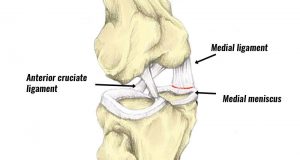Knee pain doesn’t discriminate. No matter the cause – whether it be a sports injury, ageing or daily wear and tear – knee pain can be a nuisance and often debilitating. Your knee is one of your body’s most vulnerable joints that bears significant stress throughout your everyday life. One of the most common knee injuries is a torn meniscus, when the C-shaped piece of cartilage that acts as your knee’s shock absorber, is torn.

Medial Meniscus vs Lateral Meniscus
While both the medial and lateral meniscus are C-shaped rubbery cartilage attached to your shin bone, the medial meniscus is more susceptible to injury. The key difference between the two is location, with the medial meniscus on the inner side of the knee joint and the lateral meniscus on the outside of the knee. The medial meniscus is more vulnerable due to its firm attachment to the medial collateral ligament (MCL), giving it less mobility than the lateral meniscus.
Causes of a Medial Meniscus Tear
The most common cause of a medial meniscus tear is the sudden twisting of the knee while the foot is planted in the ground. This can happen when performing sudden stops or changes of direction, or if your knee is struck during a contact sport. Another common cause of a medial meniscus tear is degenerative changes in the knee due to ageing, when the medial meniscus loses its resiliency due to degeneration, so a tear can occur with minimal or no trauma.
Signs & Symptoms of a Medial Meniscus Tear
There are several signs and symptoms that will alert you to a medial meniscus tear. If you experience any of these, you should seek help with a diagnosis and treatment.
- Moderate to severe pain in the knee
- Immediate swelling around the knee
- Reduced weight-bearing and movement
- A popping sensation
- Stiffness after injury
- Inability to straighten knee fully
- Frequent locking up of the knee
Diagnosis & Treatment
Your physiotherapist can identify a medial meniscus tear by performing various tests to pinpoint the cause of your symptoms. A diagnostic procedure, like an MRI, will confirm the diagnosis.
Medial meniscus tear treatment depends largely on the severity, location and size of your tear. An immediate treatment option is P.R.I.C.E – Protection, Rest, Ice, Compression, and Elevation to minimise damage to surrounding tissue. Staying off and immobilising your knee should also assist in reducing any swelling. This, along with physiotherapy and prescription medications, may be enough to help you recover.
If the pain persists, your doctor or physio may recommend surgery to repair the torn meniscus. Or, if the meniscus cannot be repaired, it may be surgically shortened. After surgery, you’ll need to work alongside a physiotherapist to rebuild knee strength and stability.
Prognosis
Treatment of a medial meniscus tear can take anywhere from 4 weeks to 6 months before you can return to regular activity. The short term results for those who get surgery for meniscus tear are often excellent, and physical therapy can be used to minimise complications and speed up recovery.
If you need help with knee pain or immobility, book in for your treatment now with one of our exercise, physio, or pain specialists via 1300 012 273 or book a session at your nearest clinic.

